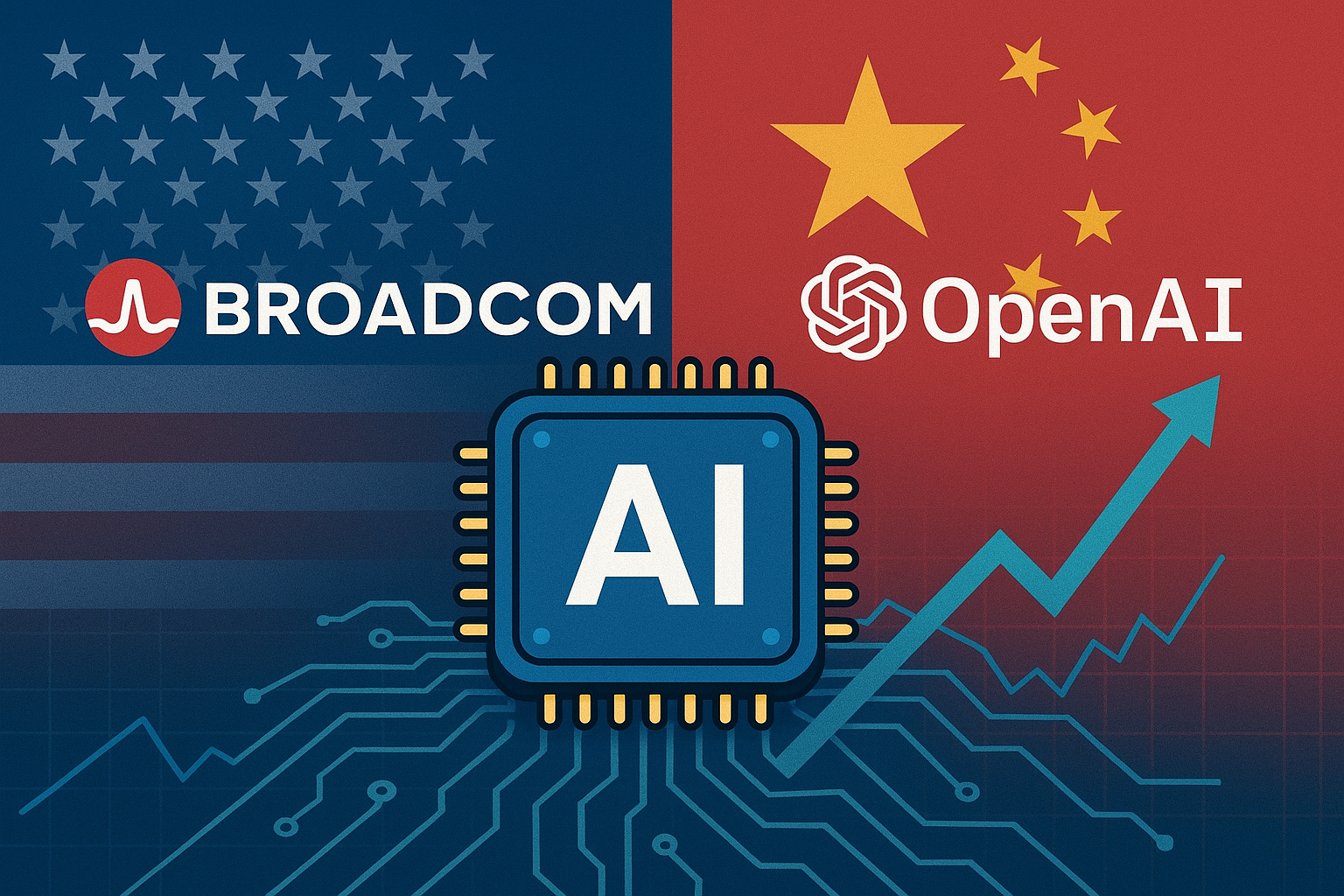Wall Street is seeing fresh optimism in the artificial intelligence hardware space after Broadcom (NASDAQ: AVGO) announced a partnership with OpenAI to co-develop next-generation AI processors. The move, confirmed Monday, comes as U.S.–China trade rhetoric softened, sparking a broad rebound in semiconductor stocks that had been under pressure in recent weeks.
For investors, this marks a pivotal inflection point in the AI infrastructure cycle — one that blends geopolitical relief with accelerating corporate investment in specialized computing power.
The AI Chip Race Enters a New Phase
Broadcom’s collaboration with OpenAI represents more than a strategic partnership — it’s a signal of the escalating arms race in AI hardware. According to Reuters, the two firms plan to develop high-performance AI processors tailored to inference and training workloads that can rival Nvidia’s (NASDAQ: NVDA) market-dominant GPUs.
The timing is critical. AI computing demand is surging globally, with market forecasts from Bloomberg Intelligence suggesting total AI chip spending could exceed $300 billion annually by 2030, driven by cloud infrastructure expansion, on-device AI applications, and government-backed digitalization programs.
In early trading, Broadcom shares surged over 4%, while peers such as AMD (NASDAQ: AMD), Marvell Technology (NASDAQ: MRVL), and Taiwan Semiconductor Manufacturing (NYSE: TSM) also posted gains. The Philadelphia Semiconductor Index (SOX) rose nearly 2%, recovering from a weeklong slide triggered by export control concerns.
Why This Matters for Investors
The Broadcom–OpenAI deal underscores a structural shift in how AI computing ecosystems are evolving. Instead of relying solely on GPU-centric architectures, the industry is moving toward custom AI accelerators — chips optimized for specific neural network workloads.
Such diversification could reshape hardware demand, with ripple effects across the semiconductor value chain — from foundries and packaging suppliers to advanced materials producers.
“What we’re witnessing is a broadening of the AI compute stack,” said a senior analyst at Wedbush Securities, noting that hyperscalers and AI developers are seeking efficiency gains amid skyrocketing infrastructure costs. “Every dollar saved per watt of compute can scale into billions in data center economics.”
That economics-driven motivation could push more tech giants to partner directly with chip designers rather than rely exclusively on off-the-shelf GPU solutions.
Geopolitical Tailwinds Add Momentum
Adding fuel to the rally, Washington’s tone toward Beijing eased after President Trump’s recent comments signaling a willingness to negotiate trade terms. The announcement came just days after heightened tensions over semiconductor export restrictions had rattled markets.
Reuters reported that the White House may delay new restrictions on advanced AI chips, a development that gave global chipmakers breathing room. As a result, investor sentiment improved sharply, with futures rising across major indexes.
While this relief may prove temporary, the recalibration of trade policy — combined with private-sector innovation — is giving investors a short-term window of opportunity to re-enter AI-related equities.
Future Trends to Watch
- Custom AI Silicon Expansion – Expect to see more co-development deals between chip designers and AI companies (e.g., Anthropic, Google DeepMind, Meta).
- Data Center Spending Surge – Capital expenditure on AI infrastructure could exceed $250 billion in 2025, according to McKinsey, with an emphasis on energy efficiency and compute density.
- Export Policy Risk – Continued U.S.–China tensions may result in cyclical volatility for semiconductor stocks, particularly those with exposure to advanced manufacturing nodes.
- Broadcom’s Strategic Diversification – Beyond networking and broadband chips, Broadcom’s pivot into custom AI silicon signals its intent to compete directly with Nvidia and potentially reduce hyperscaler dependency.
Key Investment Insight
The Broadcom–OpenAI collaboration reaffirms that AI infrastructure remains one of the most investable megatrends of the decade. Investors should monitor:
- AI hardware suppliers — Broadcom, AMD, and Marvell could gain from custom chip expansion.
- Semiconductor equipment manufacturers — Applied Materials (NASDAQ: AMAT) and ASML (NASDAQ: ASML) benefit as fabrication complexity grows.
- Data center energy plays — Companies in cooling, grid infrastructure, and power efficiency (such as Eaton, Schneider Electric, and Vertiv) stand to gain from AI-driven demand surges.
However, the race is capital-intensive. Firms with strong cash flow, strategic partnerships, and technological edge will likely emerge as long-term winners, while smaller players could face margin compression.
Stay Ahead with MoneyNews.Today
As the AI hardware race accelerates and market dynamics shift with each geopolitical headline, staying informed has never been more crucial.
Follow MoneyNews.Today for timely, data-backed insights on the forces shaping the next generation of technology and investment opportunities.





